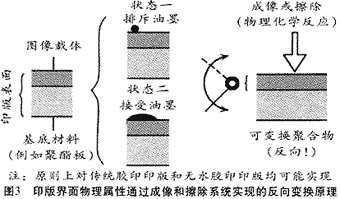The term "Switchable Polymer" appears quite frequently when referring to reproducible imaging plates. Here, the term "convertible" refers to the fact that when a material is used as a printing plate, its surface characteristics can be changed from one state to another, which is a basic characteristic that a reproducible image material should possess. On the basis of the surface characteristics of the printing plate used in the offset printing process, "changeable" means that the basic state of the surface of the printing plate material is hydrophilic (Hydrophilic), but it can be changed to another state by a specific process. Figure 3 explains the principle of inverse transformation of the surface properties of a reproducible imaging plate material.

During the transformation of the material's surface properties, physical properties of the interface can be changed by some physicochemical means, such as the transfer of ink from the surface to the accept ink.
(Oleophilic) properties, surfaces with this property are called ink-receptive surfaces. This condition is permanently stored in the material throughout the printing cycle, resulting in stable print quality and no visually visible changes to the printed image. If the image on the plate can be erased after the printing is completed, the plate can be restored to its original state, and the erasing process can also be achieved through physicochemical effects. At this point, the interface physical properties of the material have changed again, for example, from the ink-receptive state back to the hydrophilic initial state, which means that the entire surface can be dampened by the fountain solution. Therefore, the re-imageable plate material should have reversible transformation characteristics. This surface characteristic is called transformability. In addition to polymers, other materials may also have such properties, so the term "convertible polymer" may be misleading.
The basic properties of the material will determine its erasable, repeatable imaging and information recording (storage) characteristics, as well as the lifetime of the imaging results within a production cycle and the number of repeatable erasures and imaging.
It should be pointed out that the basic properties of the plate material must be matched with the imaging components used in the imaging system, as well as the process properties. That is, the physical and chemical processes generated in the plate during imaging can be reflected by different physical effects. Therefore, plate materials with different properties can be imaged by different processes such as thermal imaging, electrophotographic imaging, or ion imaging. The same kind of material may also produce a variety of process uses, such as the use of specific inks for thermal sublimation techniques for imaging on plates, or imaging through inkjet systems and image curing processes.
Multiple imaging of the printing plate can be achieved by the application and dematerialization of a certain surface property of the material, or the need to separate and rewrite the storage contents of the printing plate without the physical and chemical effects of the interface of the separately applied material.
5 Repeatable imaging plate surface material
For researchers who can reimage plate materials, the issue they care most about is the reverse of the state of the material. As long as the basic properties of the material indicate the ability to reverse change, one can try to change its surface properties. One example is the oxygen content of metal oxides such as titanates. When the oxygen content in the metal oxide is different, the material has different writing characteristics. When the oxygen content of the surface material is in a normal state, its basic characteristics are hydrophilic, and laser radiation can be used to reduce the oxygen content, thereby converting the surface characteristics of the material into lipophilic. When it is necessary to return it to its original state, the material may be heat-treated to restore the oxygen content of the surface material to a normal level and thus become hydrophilic again.
Similarly, it is possible to restore a photocatalytic material such as zinc oxide or titanate to a hydrophilic (ink repellent) state by a suitable radiation action.
The interfacial physics of the polymer is contrary to the material properties mentioned above. It has a functional side chain structure such as Fluoropolymer. Some of these materials are associated with PTFE (known as Teflon) and can be used as offset repetitive imaging surfaces. For these materials, the term polymer can be adapted. (Author: Yao Hagen)
Erasme Luxury High Chair With Wheels
Zhejiang Lamon Technology Inc. , https://www.babychaires.com